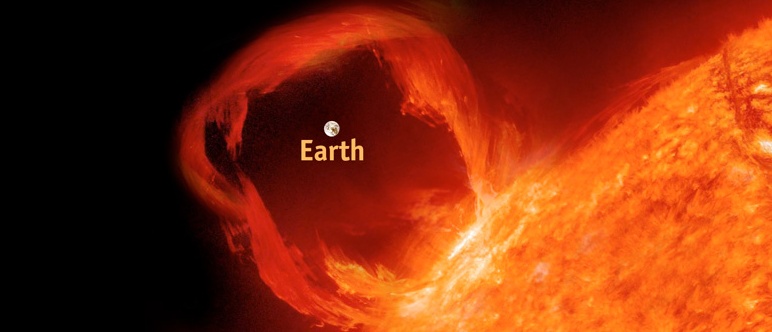Evidence for an extreme solar proton event around 660 BC

An increasing amount of research indicates that solar storms can be even more powerful than measurements have shown so far via direct observations. Researchers believe that society is not sufficiently prepared if a similar event were to happen now.
The researchers behind the new, international study led by researchers from Lund University have used drilled samples of ice, or ice cores, to find clues about previous solar storms. The cores come from Greenland and contain ice formed over the past about 100 000 years. The material contains evidence of a very powerful solar storm that occurred in 660 BCE.
"If that solar storm had occurred today, it could have had severe effects on our high-tech society," says Raimund Muscheler, professor of geology at Lund University.
The new study means that a third known case of a massive solar storm dating back in time has been discovered via indirect observations in nature’s own archive. Raimund Muscheler also took part in research that confirmed the existence of two other massive solar storms, using both ice cores and the annual growth rings of old trees. These storms took place in 775 and 994 CE.
Regarding number of high-energy protons, the 660 BCE and the 775 CE events are about 10 times larger than the strongest proton storm seen in the modern day, which occurred in 1956, Muscheler said. The 993-994 CE event was smaller than the other two ancient storms by about a factor of two to three, he added.
It remains unclear how these ancient proton storms compared with the Carrington Event of 1859, since estimates of the number of protons from the Carrington Event are very uncertain, Muscheler said.
However, if these ancient solar outbursts were connected with a geomagnetic storm, I would assume that they would exceed the worst-case scenarios that are often based on Carrington-type events, he noted.
Muscheler further points out that, even though these massive solar storms are rare, the new discovery shows that they are a naturally recurring effect of solar activity.
"That’s why we must increase society’s protection again solar storms," he says.
Today’s risk assessment is largely based on direct observations made over the past 70 years, but Raimund Muscheler suggests that there is a need for a reassessment in view of the three massive solar storms that have now been discovered. He argues that there is a need for greater awareness of the possibility of very strong solar storms and the vulnerability of our society.
"Our research suggests that the risks are currently underestimated. We need to be better prepared," Muscheler concludes.
Reference:
"Multiradionuclide evidence for an extreme solar proton event around 2,610 B.P. (∼660 BC)" – Paschal O’Hare, Florian Mekhaldi, Florian Adolphi, Grant Raisbeck, Ala Aldahan, Emma Anderberg, Jürg Beer, Marcus Christl, Simon Fahrni, Hans-Arno Synal, Junghun Park, Göran Possnert, John Southon, Edouard Bard, ASTER Team, and Raimund Muscheler – PNAS published ahead of print March 11, 2019 – https://doi.org/10.1073/pnas.1815725116
Abstract
Recently, it has been confirmed that extreme solar proton events can lead to significantly increased atmospheric production rates of cosmogenic radionuclides. Evidence of such events is recorded in annually resolved natural archives, such as tree rings [carbon-14 (14C)] and ice cores [beryllium-10 (10Be), chlorine-36 (36Cl)]. Here, we show evidence for an extreme solar event around 2,610 years B.P. (∼660 BC) based on high-resolution 10Be data from two Greenland ice cores. Our conclusions are supported by modeled 14C production rates for the same period. Using existing 36Cl ice core data in conjunction with 10Be, we further show that this solar event was characterized by a very hard energy spectrum. These results indicate that the 2,610-years B.P. event was an order of magnitude stronger than any solar event recorded during the instrumental period and comparable with the solar proton event of AD 774/775, the largest solar event known to date. The results illustrate the importance of multiple ice core radionuclide measurements for the reliable identification of short-term production rate increases and the assessment of their origins.
Featured image credit: NASA/SDO

That our society is as flexible as clay is due to the insights of engineers and the shortcoming of humans to limit themselves: electrons have to do all the work humans are doing. On what is their believe based upon? To my opinion it is not a believe but only a speculative thought.
YOUR STANDARD SOLAR DOGMA REQUIRES A NEW THEORETICAL MODEL TO EXPLAIN THE EXTREME VARIATIONS IN THE INTENSITY OF SOLAR STORMS.